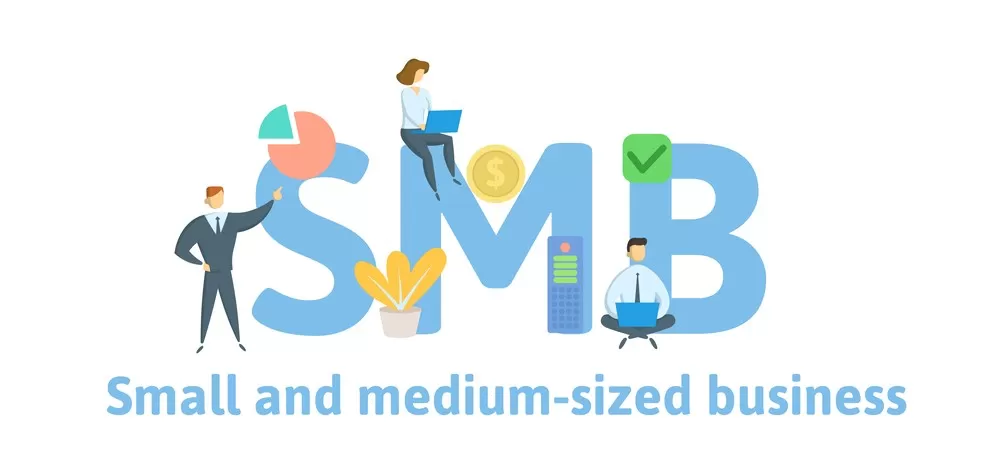Written By:
Scott McAuley
Scott is the IT Director of Texas Management Group, and has been in the IT industry for 25 years.
Did you know that small and medium-sized businesses (SMBs) account for over 90% of all businesses worldwide? These local businesses play a significant role in driving economic growth and employment opportunities. In today’s digital age, the adoption of strategic technology has become more crucial than ever for SMBs to stay competitive and thrive in the market.
From growing SMBs to entrepreneurs starting their businesses, embracing technology solutions can provide SMBs with the tools they need to streamline operations, make data-driven decisions, enhance customer experiences, and gain a competitive edge over their competitors.
In this article, we will explore the reasons why SMBs should adopt technology strategically and provide insights into how they can do it effectively.
Whether you are a business owner looking to scale your operations or an entrepreneur starting a new venture, understanding the importance and benefits of technology adoption for SMBs is essential in today’s fast-paced business landscape.
Key Takeaways
- Strategic technology adoption is essential for SMBs to remain competitive and thrive in the digital age. It enhances efficiency, streamlines operations, and enables data-driven decisions that provide a significant market advantage.
- By leveraging cloud computing, AI, IoT, and cybersecurity solutions, SMBs can improve efficiency, decision-making, customer experience, and scalability while reducing costs and mitigating risks, setting the foundation for sustainable growth.
- A thorough assessment of current tech landscapes and business needs is the first step in technology adoption. Setting clear goals, researching options, and creating a detailed implementation plan ensures effective integration of new technologies.
- Investing in employee training and change management is crucial for successful technology adoption. Comprehensive training helps employees adapt to new systems, while change management strategies address resistance and ensure smooth transitions.
- Staying informed about future trends, such as remote work, AI, and cybersecurity, is vital for SMBs to maintain a competitive edge. Adapting to these trends will enable businesses to thrive and navigate challenges in a rapidly evolving landscape.
Table of Contents
What are SMBs?

SMB stands for small and medium-sized businesses. These businesses are defined by their smaller scale and workforce compared to large corporations. SMBs play a vital role in the economy, contributing to job creation and innovation.
They encompass a wide range of industries and sectors, including local retail stores, professional services firms, and more. SMBs are often the backbone of local communities and contribute significantly to the growth and vibrancy of the business landscape.
Understanding Strategic Technology Adoption

Strategic technology adoption is a crucial process for SMBs to embrace in order to stay competitive in today’s digital landscape. It involves the deliberate and planned integration of technology solutions into the operations of SMBs, with the goal of enhancing efficiency, driving digital transformation, and gaining a competitive edge in the market.
At its core, strategic technology adoption is about identifying the right technologies that align with the business goals of SMBs. This requires a thorough understanding of the specific needs and challenges of the SMB, as well as the available technology options. By carefully selecting and implementing the right technologies, SMBs can maximize the benefits and impact of technology adoption.
One of the key reasons SMBs should focus on strategic technology adoption is to embrace digital transformation. In today’s fast-paced business environment, digital transformation is crucial for SMBs to remain relevant and competitive. By strategically adopting technology solutions, SMBs can streamline their operations, automate processes, and leverage data to make better-informed decisions.
Strategic technology adoption also plays a vital role in enhancing efficiency within SMBs. By implementing technologies that optimize workflows and automate manual tasks, SMBs can save time and resources, allowing their teams to focus on more strategic and value-added activities. This increased efficiency can lead to improved productivity and overall business performance.
In addition to efficiency and digital transformation, strategic technology adoption provides SMBs with a competitive edge. By staying ahead of the curve and adopting the right technologies, SMBs can differentiate themselves from competitors, attract new customers, and retain existing ones. This gives them a unique advantage in the market and allows them to thrive in the ever-evolving business landscape.
Importance of Technology Adoption for SMBs
Technology adoption is crucial for small and medium-sized businesses (SMBs) to thrive in today’s rapidly evolving business landscape. By strategically adopting technology solutions, SMBs can streamline their operations, improve efficiency, make better-informed decisions, enhance customer experience, and gain a competitive advantage.
Technology adoption allows SMBs to leverage data and analytics, enabling them to gain valuable insights and make data-driven decisions. By harnessing the power of technology, SMBs can automate processes, optimize resource allocation, and scale their businesses effectively.
6 Steps on How SMBs Can Strategically Adopt Technology
Strategically adopting technology is crucial for small and medium-sized businesses (SMBs) to stay competitive in today’s digital landscape.
By following these six steps, SMBs can ensure a successful technology adoption process:
| Step | Description |
|---|---|
| Assess Current Tech Landscape and Business Needs | Evaluate existing systems, processes, and capabilities to identify gaps that technology can address |
| Set Clear Adoption Goals and Objectives | Define specific, measurable, achievable, relevant, and time-bound goals aligned with overall business strategies |
| Research Available Technologies Thoroughly | Evaluate different vendors, compare features, functionalities, and costs to find the right technology solutions |
| Develop Adoption Roadmap and Implementation Plan | Create a detailed plan outlining the step-by-step process of integrating technologies into operations |
| Invest in Employee Training and Change Management | Provide comprehensive training programs and implement change management strategies to ensure smooth adoption |
| Monitor and Evaluate Adoption Outcomes | Evaluate different vendors, and compare features, functionalities, and costs to find the right technology solutions |
1. Assess Current Tech Landscape and Business Needs
The first step in strategic technology adoption is to assess the current tech landscape of your SMB and identify the specific business needs that technology can address. Evaluate your existing systems, processes, and capabilities to understand the gaps that need to be filled with technology solutions.
2. Set Clear Adoption Goals and Objectives
To drive successful adoption, set clear adoption goals and objectives that align with your overall business strategies. These goals should be specific, measurable, achievable, relevant, and time-bound (SMART goals). Tracking your progress will help ensure that technology adoption is driving the desired outcomes.
3. Research Available Technologies Thoroughly
Thoroughly research available technologies to identify the ones that best align with your SMB’s needs and goals. Evaluate different vendors, compare features and functionalities, consider cost implications, and seek recommendations from trusted sources. The goal is to find the right technology solutions that fit your specific requirements.
4. Develop an Adoption Roadmap and Implementation Plan
Once you’ve identified the appropriate technologies, develop an adoption roadmap and implementation plan. This plan outlines the step-by-step process of integrating the technologies into your SMB’s operations. Include timelines, resource allocation, training requirements, and milestones to ensure a smooth and successful implementation.
5. Invest in Employee Training and Change Management
Invest in comprehensive employee training programs to ensure that your staff has the necessary skills and knowledge to utilize the new technologies effectively. Implement change management strategies to address any resistance to change and ensure a smooth transition throughout your organization.
6. Monitor and Evaluate Adoption Outcomes
Continuously monitor and evaluate the outcomes of your technology adoption initiatives. Track key performance indicators (KPIs) related to the adopted technologies and assess their impact on your business. This ongoing evaluation will help you make adjustments and improvements to maximize the benefits of technology adoption.
7 Benefits of Strategic Technology Adoption for SMBs
Strategic technology adoption offers numerous benefits for small and medium-sized businesses (SMBs). By embracing technology solutions, SMBs can enhance efficiency, improve decision-making, enhance customer experience, gain a competitive advantage, achieve scalability, realize cost savings, and mitigate potential risks.
| Benefit | Description |
|---|---|
| Enhanced Efficiency | Automates manual processes and streamlines operations, reducing human error and increasing productivity. |
| Improved Decision-Making | Accesses real-time data and analytics to make informed and data-driven decisions. |
| Enhanced Customer Experience | Delivers personalized and seamless experiences, anticipating customer needs and improving satisfaction and loyalty. |
| Competitive Advantage | Differentiates from competitors, attracting and retaining customers in a digital and competitive landscape. |
| Scalability | Enables effective scaling of operations with flexible and scalable infrastructure solutions. |
| Cost Savings | Reduces manual labor and optimizes resource allocation, resulting in overall cost reduction. |
| Risk Mitigation | Mitigates risks in cybersecurity and data protection through robust security measures and best practices. |
1. Enhanced Efficiency
Strategic technology adoption improves efficiency by automating manual processes, streamlining operations, and reducing human error. This allows SMBs to save time and resources, increasing productivity and overall efficiency.
2. Improved Decision-Making
By leveraging technology solutions, SMBs can access real-time data and analytics, enabling them to make data-driven decisions. This improves transparency, accuracy, and speed in decision-making, leading to more informed and effective business strategies.
3. Enhanced Customer Experience
Technology adoption allows SMBs to deliver personalized and seamless customer experiences. CRM systems, chatbots, and other customer-centric technologies enable SMBs to better understand and anticipate customer needs, leading to improved customer satisfaction and loyalty.
4. Competitive Advantage
SMBs that strategically adopt technology gain a competitive advantage in the market. By leveraging innovative technologies, SMBs can differentiate themselves from competitors, attract new customers, and retain existing ones. This gives them an edge in the increasingly digital and competitive business landscape.
5. Scalability
Strategic technology adoption enables SMBs to scale their operations effectively. Cloud computing, for example, provides flexible and scalable infrastructure solutions that can grow with the business. This allows SMBs to adapt to changing market demands and expand their reach without significant infrastructure investments.
6. Cost Savings
Adopting technology can result in cost savings for SMBs. Automation and digitization of processes reduce the need for manual labor, saving both time and costs. Technology solutions can also optimize resource allocation and minimize inefficiencies, resulting in overall cost reduction.
7. Risk Mitigation
Technology adoption helps SMBs mitigate risks, particularly in the areas of cybersecurity and data protection. Implementing robust security measures and staying up-to-date with the latest technologies and best practices reduce the risk of data breaches, financial losses, and reputational damage.
Best Technological Advancements for SMBs
SMBs have access to a wide range of technological advancements that can greatly benefit their operations. By strategically adopting these innovations, SMBs can improve efficiency, enhance decision-making, optimize customer experience, gain a competitive advantage, achieve scalability, and ensure cybersecurity.
Here are some of the best technological advancements for SMBs:
- Cloud Computing: Cloud computing offers SMBs scalable and cost-effective infrastructure solutions. It enables them to access and store data, host websites and applications, and run business operations in a flexible and secure manner.
- AI and Machine Learning: AI and machine learning technologies empower SMBs to automate tasks, analyze data, and make data-driven decisions. From chatbots for customer support to predictive analytics for forecasting, AI and machine learning boost efficiency and drive innovation.
- Internet of Things (IoT): IoT allows SMBs to connect devices and collect valuable data for real-time insights. From smart sensors in manufacturing processes to connected devices in logistics, IoT enables SMBs to optimize operations, improve efficiency, and enhance customer experiences.
- Cybersecurity Solutions: With the increasing threat of cyber attacks, cybersecurity solutions are essential for SMBs. Robust security measures, such as firewalls, antivirus software, and encryption, help protect SMBs’ sensitive data and ensure business continuity.
By strategically adopting these technological advancements, SMBs can leverage their benefits and stay competitive in today’s rapidly evolving digital landscape.
Future Trends and Considerations

The future of technology adoption for SMBs is influenced by various trends and considerations that require attention. It is important for SMBs to stay informed and adapt to these changes to stay ahead in the digital landscape.
One significant trend is the continued growth of remote work. As more businesses embrace remote work arrangements, SMBs need to invest in remote collaboration tools to enable effective communication and collaboration among remote teams. Additionally, cybersecurity measures must be prioritized to protect sensitive data and prevent cyber threats.
Furthermore, the role of artificial intelligence (AI) and automation in streamlining operations and enhancing efficiency cannot be ignored. SMBs that leverage AI-powered technologies and automation solutions can streamline repetitive tasks, reduce costs, and improve productivity. Embracing AI and automation can help SMBs stay competitive in a rapidly evolving business environment.
Cybersecurity remains a vital consideration for SMBs. With the increase in data breaches and cyber threats, SMBs need to prioritize cybersecurity measures to protect their sensitive data, customer information and ensure business continuity. Implementing robust security protocols and regularly updating security systems are crucial steps in safeguarding against potential threats.
In summary, SMBs should keep an eye on future trends in technology adoption, including the growth of remote work, the role of AI and automation, and the importance of cybersecurity. Staying informed and adapting to these trends will enable SMBs to thrive in the digital age and maintain a competitive edge.
Conclusion
Strategic technology adoption is crucial for the success and growth of small and medium-sized businesses (SMBs). By embracing technology solutions, SMBs can enhance efficiency, improve decision-making, enhance customer experience, gain a competitive advantage, achieve scalability, save costs, and mitigate risks.
SMBs should continuously stay ahead of future trends and adapt their technology adoption strategies to remain competitive in the evolving digital landscape. As remote work continues to grow, investing in remote collaboration tools and cybersecurity measures will be essential. Leveraging artificial intelligence (AI) and automation can streamline operations and increase efficiency.
It is clear that strategic technology adoption is no longer a luxury for SMBs – it is a necessity. As technology continues to advance at a rapid pace, SMBs must embrace and adapt to these changes to thrive in the digital age. By doing so, SMBs can position themselves for long-term success and achieve their business goals.
Interested in a Smarter Approach to Tech Adoption?
Find expert advice in our blogs on the best practices, and see how our IT Consulting Services can help your SMB grow with the right solutions.
Empower your team with tech today!
FAQ
How Can Technology Improve Business?
Technology can improve business by streamlining processes, enhancing communication, increasing efficiency, and enabling better decision-making through data analytics and automation.
How Does the use of Technology Contribute to the Growth of Business?
The use of technology contributes to business growth by opening new markets, improving customer engagement, reducing operational costs, fostering innovation, and providing a competitive edge in the digital economy.
How can Technology Solve Business Problems?
Technology can solve business problems by offering scalable solutions for managing data, optimizing workflows, addressing customer needs, mitigating risks, and adapting to changing market dynamics more effectively than traditional methods.
Why is it Important to Adopt the Latest Trends in Technology?
Adopting the latest trends of technology is important to stay competitive, innovate, meet customer expectations, enhance operational efficiency, and future-proof the business against emerging challenges and disruptions in the market.






